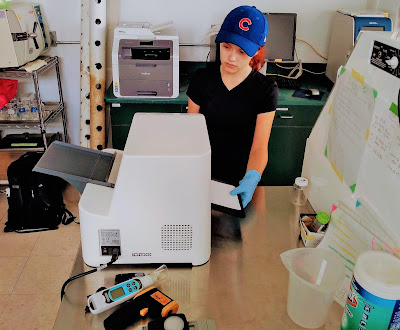By Cynthia Gutierrez Navarro
My project evaluates levels of Fecal Indicator Bacteria (specifically E. coli and coliforms) with respect to invasive plant species in a network of bioswales at Lake St. Clair Metropark.
In 2013, Lake St. Clair underwent a 5-million-dollar green space renovation in order to create a network of 8 bioswales that would redirect stormwater runoff into Point Rosa marsh.
Bioswales are networks of green space infrastructure designed to mimic natural systems and redirect storm water runoff to Point Rosa Marsh at Lake St. Clair Metropark.
 |
| Collecting water samples and water chemistry data of bioswales-network at Lake St. Clair Metropark. Photo: Cynthia Gutierrez Navarro |
Invasive plant species, Phragmites australis (Common Reed) and Hydrocharis morsus-ranae (European Frogbit) have overtaken the bioswales and marsh. We know from primary literature that invasive species can alter bacterial communities.
My research has shown that the bioswale network is failing to sustain fecal indicator bacteria levels at EPA limits for recreational water regardless of the presence or absence of invasive plants. All bioswales scored (statistically) at or above EPA limits for both E. coli and coliforms.
My project is in collaboration with Lake St. Clair Metropark and Wayne State University. One of the most enjoyable parts of my summer internship is the collaborative experience I’ve had with other researchers.
My project is in collaboration with Lake St. Clair Metropark and Wayne State University. One of the most enjoyable parts of my summer internship is the collaborative experience I’ve had with other researchers.
 |
| Running into Brittany Bonnic-Khalil, lab manager at Wayne State University's HEART field station at Lake St. Clair. Photo: Cynthia Gutierrez Navarro |
 |
| Analyzing IDEXX results after 24-hour incubation period. A yellow appearance in the Quanti-tray sleeve results positive for total coliforms in the sample. Photo: Cynthia Gutierrez Navarro |
 |
| Using IDEXX sealer housed in WSU's HEART lab to quantify total coliforms and E. coli. Photo: Cynthia Gutierrez Navarro |
